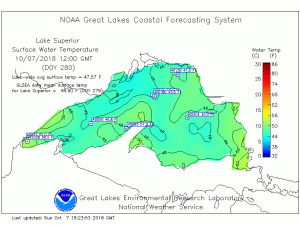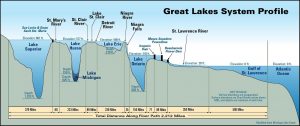Lake Superior rapidly warming
Oct 10, 2018 01:36PM ● By Editor
Photo: Early Morning Sun over the lake, Photo by Dieter G via goodfreephotos.com cc 0.0
By Jack Nissen from greatlakesnow.org - October 10, 2018
The Great Lakes are running a fever, and Lake Superior is heating up the fastest.
There’s no single reason for the rise in temperature. Rather, it’s due to a combination of warming winters, more sunlight and increasing air temperatures. That was the conclusion a 2015 scientific study that looked at 235 lakes around the world.
And one of its authors has little reason to believe that trend won’t continue.
“It’s like a perfect storm of effects hitting Lake Superior,” said John Lenters, an honorary fellow with the Center for Limnology at the University of Wisconsin. “We’re pretty sure warming has continued, because global air temperature has continued to rise.”
The average rate of warming lakes across the globe is .34 degrees Celsius per decade. Lake Superior is heating up at three times that pace.
One of the obvious reasons are the warming air temperatures. A direct effect of global warming, regions further north feel these changes the most due to the historic presence of snow and ice. However, that presence is slowly declining.
“There is a positive feedback loop, because snow and ice tend to reflect more sunlight, and so it keeps that region cool,” he said. “When you get rid of snow and ice, more sunlight gets absorbed and the region warms up even faster.”
“The lake has a ‘longer memory’ than a lake like Lake Erie”
All five Great Lakes are at the mercy of this process. However, it’s Lake Superior’s depth which makes its rapid warming distinct from other Great Lakes.
“The lake has a ‘longer memory’ than a lake like Lake Erie. It takes a longer time to recover from a warm winter,” said Jay Austin, a physical limnology and oceanography professor at the University of Minnesota Duluth, “and it’s not so much that the summers are getting warmer, but the winters have gotten a lot more mild.”
That extreme depth gives Lake Superior a unique quality that shows itself during the warmest and coldest months of the year, when its water separates into different layers — a process known as stratification.
In the summer, warm air temperatures heat up a thin layer of water on top of the cooler section of the lake. Then as air temperatures drop, the warm and cold layers will mix. That’s until cold air temperatures in the winter chill the top layer of water, before eventually turning into ice.
“That whole process helps dictate what the surface temperatures are on these dimictic lakes, and when they occur has a big effect on these deep lakes,” said Lenters.
It takes about three months for stratification to occur. But an increasingly warm winter means the process is happening sooner, giving the lake more room to warm.
“The possibility for algal blooms in the water”
“During these warm years, Lake Superior’s stratification date in the deepest parts of the lake are shifting from Aug. 15 to July 15, to in some cases, late June,” Lenters said. “And because it’s stratifying so much earlier in the year, that warm layer that forms in the summer has a lot more time to warm up rapidly.”
Tacking on a third driver of this change is a meteorological shift : summer is getting sunnier. Less cloud cover and more clear skies are allowing more sunlight to hit the lake’s surface, which begins to absorb more heat in the process.
Those shifting temperatures are increasing the possibility for algal blooms in the water. But the impacts don’t stop at the biological stage. They dip into the physical as well, with earlier evaporation occurring.
“Lakes tend to go through a seasonal cycle, with high evaporation mostly in the late fall and early winter,” Lenters said. “What we’ve seen in some of these warm years is that in the summer evaporation season, instead of starting on the 1st of August, it starts the 1st of July.”
“We’re losing four inches above normal every year”
“When you give the lake a head start on evaporating, it tends to evaporate more by the end of the following year.”
This was most noticeable in 2010, when about four inches of water was observed evaporating from the lake. That’s a lot of water the lake is shedding. One anomalous year doesn’t bother Lenters. But he said if it becomes the norm, that’s when worry should set in.
“The concern is not that ‘oh we had this one year, this one blip we lost four inches of water,’” he said. “The concern is if 2010 becomes a more normal type of year, where we have every year that is that warm, then we’re losing four inches above normal every year.”



